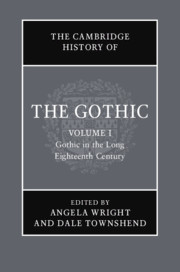Book contents
- The Cambridge History of the Gothic
- The Cambridge History of the Gothic
- The Cambridge History of the Gothic
- Copyright page
- Contents
- Illustrations and Captions for Volume I
- Notes on Contributors
- Acknowledgements
- Introduction: The Gothic in/and History
- 1.1 The Goths in Ancient History
- 1.2 The Term ‘Gothic’ in the Long Eighteenth Century, 1680‒1800
- 1.3 The Literary Gothic Before Horace Walpole’s The Castle of Otranto
- 1.4 Gothic Revival Architecture Before Horace Walpole’s Strawberry Hill
- 1.5 Horace Walpole and the Gothic
- 1.6 Shakespeare’s Gothic Transmigrations
- 1.7 Reassessing the Gothic/Classical Relationship
- 1.8 ‘A World of Bad Spirits’: The Terrors of Eighteenth-Century Empire
- 1.9 In Their Blood: The Eighteenth-Century Gothic Stage
- 1.10 Domestic Gothic Writing after Horace Walpole and before Ann Radcliffe
- 1.11 Early British Gothic and the American Revolution
- 1.12 Gothic and the French Revolution, 1789–1804
- 1.13 The Aesthetics of Terror and Horror: A Genealogy
- 1.14 Ann Radcliffe and Matthew Lewis
- 1.15 The Gothic Novel Beyond Radcliffe and Lewis
- 1.16 Oriental Gothic: Imperial-Commercial Nightmares from the Eighteenth Century to the Romantic Period
- 1.17 The German ‘School’ of Horrors: A Pharmacology of the Gothic
- 1.18 Gothic and the History of Sexuality
- 1.19 Gothic Art and Gothic Culture in the Romantic Era
- 1.20 Time in the Gothic
- Select Bibliography
- Index
1.16 - Oriental Gothic: Imperial-Commercial Nightmares from the Eighteenth Century to the Romantic Period
Published online by Cambridge University Press: 16 July 2020
- The Cambridge History of the Gothic
- The Cambridge History of the Gothic
- The Cambridge History of the Gothic
- Copyright page
- Contents
- Illustrations and Captions for Volume I
- Notes on Contributors
- Acknowledgements
- Introduction: The Gothic in/and History
- 1.1 The Goths in Ancient History
- 1.2 The Term ‘Gothic’ in the Long Eighteenth Century, 1680‒1800
- 1.3 The Literary Gothic Before Horace Walpole’s The Castle of Otranto
- 1.4 Gothic Revival Architecture Before Horace Walpole’s Strawberry Hill
- 1.5 Horace Walpole and the Gothic
- 1.6 Shakespeare’s Gothic Transmigrations
- 1.7 Reassessing the Gothic/Classical Relationship
- 1.8 ‘A World of Bad Spirits’: The Terrors of Eighteenth-Century Empire
- 1.9 In Their Blood: The Eighteenth-Century Gothic Stage
- 1.10 Domestic Gothic Writing after Horace Walpole and before Ann Radcliffe
- 1.11 Early British Gothic and the American Revolution
- 1.12 Gothic and the French Revolution, 1789–1804
- 1.13 The Aesthetics of Terror and Horror: A Genealogy
- 1.14 Ann Radcliffe and Matthew Lewis
- 1.15 The Gothic Novel Beyond Radcliffe and Lewis
- 1.16 Oriental Gothic: Imperial-Commercial Nightmares from the Eighteenth Century to the Romantic Period
- 1.17 The German ‘School’ of Horrors: A Pharmacology of the Gothic
- 1.18 Gothic and the History of Sexuality
- 1.19 Gothic Art and Gothic Culture in the Romantic Era
- 1.20 Time in the Gothic
- Select Bibliography
- Index
Summary
This chapter considers the intersection of Gothic and Orientalism in the long eighteenth century from the joint perspective of its origins and ideological relevance. Having traced the influence on Gothic of literary materials imported from the East, it examines the terrifying effects of commercial and imperial concerns in works such as William Beckford’s Vathek, Charlotte Dacre’s Zofloya, Matthew Gregory Lewis’s ‘The Anaconda’, Mary Shelley’s Frankenstein and Charles Robert Maturin’s Melmoth the Wanderer. The relevance of this commercial and imperial imaginary for figurations of subjectivity, the body and sexuality is then explored with reference to George Colman’s Blue-Beard, Robert Southey’s The Curse of Kehama, Byron’s ‘Turkish Tales’, Walter Scott’s ‘The Surgeon’s Daughter’ and the anonymous novel The Lustful Turk. Through its double focus, the chapter argues that, if the East is a foundational feature in early Gothic, the troubling power of Orientalist Gothic depends on distance and alienness, though also, and more perturbingly, on the proximity and contact promoted by an expanding commercial and territorial imperialism.
- Type
- Chapter
- Information
- The Cambridge History of the GothicVolume 1: Gothic in the Long Eighteenth Century, pp. 345 - 363Publisher: Cambridge University PressPrint publication year: 2020

